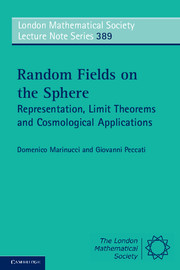Book contents
- Frontmatter
- Contents
- Preface
- 1 Introduction
- 2 Background Results in Representation Theory
- 3 Representations of SO(3) and Harmonic Analysis on S2
- 4 Background Results in Probability and Graphical Methods
- 5 Spectral Representations
- 6 Characterizations of Isotropy
- 7 Limit Theorems for Gaussian Subordinated Random Fields
- 8 Asymptotics for the Sample Power Spectrum
- 9 Asymptotics for Sample Bispectra
- 10 Spherical Needlets and their Asymptotic Properties
- 11 Needlets Estimation of Power Spectrum and Bispectrum
- 12 Spin Random Fields
- 13 Appendix
- References
- Index
12 - Spin Random Fields
Published online by Cambridge University Press: 07 October 2011
- Frontmatter
- Contents
- Preface
- 1 Introduction
- 2 Background Results in Representation Theory
- 3 Representations of SO(3) and Harmonic Analysis on S2
- 4 Background Results in Probability and Graphical Methods
- 5 Spectral Representations
- 6 Characterizations of Isotropy
- 7 Limit Theorems for Gaussian Subordinated Random Fields
- 8 Asymptotics for the Sample Power Spectrum
- 9 Asymptotics for Sample Bispectra
- 10 Spherical Needlets and their Asymptotic Properties
- 11 Needlets Estimation of Power Spectrum and Bispectrum
- 12 Spin Random Fields
- 13 Appendix
- References
- Index
Summary
Introduction
In the previous chapters of this book, we provided a systematic analysis of scalar-valued spherical random fields, with special emphasis on applications in astrophysics and cosmology. These same fields of applications are now prompting stochastic models which are more sophisticated (and more intriguing) than ordinary, scalar-valued random fields. For instance, in areas as diverse as brain imaging and astrophysics more and more examples are emerging of random fields which do not take ordinary (scalar) values, but rather have a domain given by more sophisticated mathematical structures. In this final chapter, we shall be again concerned with astrophysical and cosmological applications, but several related issues can be found in other disciplines, see for instance [178] for related mathematical models in the field of brain mapping.
In particular, almost all mathematical statistics papers in the CMB area have been concerned with the temperature component of this radiation; however, most recent and forthcoming experiments (such as Planck, which was launched on May 14, 2009, or the projected mission CMBPOL) are focussing on a more complex and elusive feature, namely the so-called polarization of the Cosmic Microwave Background. The physical significance of the latter is explained for instance in [33, 181] and [108]; we do not enter into these motivations here, but we do stress how the analysis of such a feature is supposed to provide extremely rewarding physical informations.
- Type
- Chapter
- Information
- Random Fields on the SphereRepresentation, Limit Theorems and Cosmological Applications, pp. 282 - 311Publisher: Cambridge University PressPrint publication year: 2011



